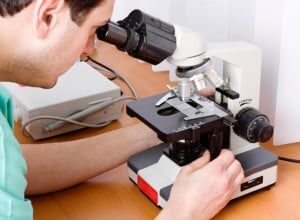
 People often assume a woman is infertile if she and her partner cannot conceive; however, this is not always the case. Males play a big role in fertility, accounting for at least 35% of infertility cases. Therefore, in order to test a male's fertility, a semen analysis is performed. A semen analysis provides both qualitative and quantitative information.
People often assume a woman is infertile if she and her partner cannot conceive; however, this is not always the case. Males play a big role in fertility, accounting for at least 35% of infertility cases. Therefore, in order to test a male's fertility, a semen analysis is performed. A semen analysis provides both qualitative and quantitative information.
Qualitative information includes: turbidity, viscosity, liquification, and gel. Turbidity describes the appearance of the specimen. Viscosity describes the length of the semen thread. Liquification describes the consistencies of the specimen and gel describes if there are clear gel clumps within the specimen.
Quantitative information includes the sample volume, total count of motile (live) and non-motile (dead) sperm, motility percent, motility grade profile, total motile sperm per sample, pH, white blood cell count, agglutination and if necessary, vitality and fructose count.
The final quantitative test is called Kruger's Strict Morphology Criteria which has defined limits for size and shape of each individual sperm.
You are probably wondering, "What makes a good semen sample?" A good semen sample is grey-to-white opalescent fluid, it should have a thread from 3 to 5cm long, be a homogenous mixture without gel. For quantitative purposes every male is different however, the ideal volume of sperm is from 1 to 5mL.
According to the World Health Organization criteria (1997) a normal count is greater than 20 million and motility is greater than 50%. The total motile sperm count should be at least 10 million.
The specimen is then looked at under a compound microscope and its motile and non-motile sperm is counted. From these results, andrologists conclude the motility percent and the total motile sperm per sample. For this, there is no right or wrong answer as long as sperm is present; in other words, more is better but every male is different.
Motility grade profile is determined by looking under the compound microscope and grading how fast the motile and non-motile sperm are moving as a grade of A, B, or C.
The white blood cell count in a male should be less than one. If there is more than one white blood cell in the specimen the male should speak with his doctor.
The pH of a semen sample should be slightly basic with a pH range between 7.2-8.0.
Agglutination occurs when the spermatozoas are clumped together; however, this may throw off the count and may interfere with the spermatozoas ability to move.
Only if there is no sperm present will the specimen be looked at further to determine the vitality and fructose count.
The final step of a semen analysis is performing a Kruger's Strict Morphology. A Kruger's Strict Morphology is a stained slide made from the semen sample which is looked at under the scope to identify normal and abnormal spermatozoa. A normal fertile specimen has 14% or higher of normal spermatozoa. Normal spermatozoa from 5-14% are good but classified as a borderline and any normal spermatozoon from 0-4% is considered poor and sub-fertile.
In order to have good seminal quality couples should be sexually abstinence for 2-4 days prior to providing a sample to the laboratory. Also, males should live a healthy lifestyle: no smoking, only a few drinks every once in a while, and staying in shape.
The average cost for these tests is $250, but we are now able to offer thorough semen analysis for just $75 applied to patients' insurance deductible.
For a thorough, expert semen analysis that is applied toward your insurance deductible, schedule an appointment at one of InVia's four Chicago area fertility clinics.
Infertility Infertility treatment Conception InVia Fertility Specialists Embryology

Kelly Schorsch is one of the members of the Embryology team at InVia Fertility. She works in both the Andrology and Embryology sections. She completed her graduate studies at Eastern Virginia Medical School in Clinical Embryology and Andrology and her undergraduate studies at Roosevelt University with a major in Biology, minor in Chemistry, and certificate in Biotechnology. She loves to be behind the scenes in the laboratory to help couples achieve their dreams of one day having a baby.
Subscribe to our weekly blog digest

Entire Website © 2003 - 2020
Karande and Associates d/b/a InVia
Fertility Specialists

Comments